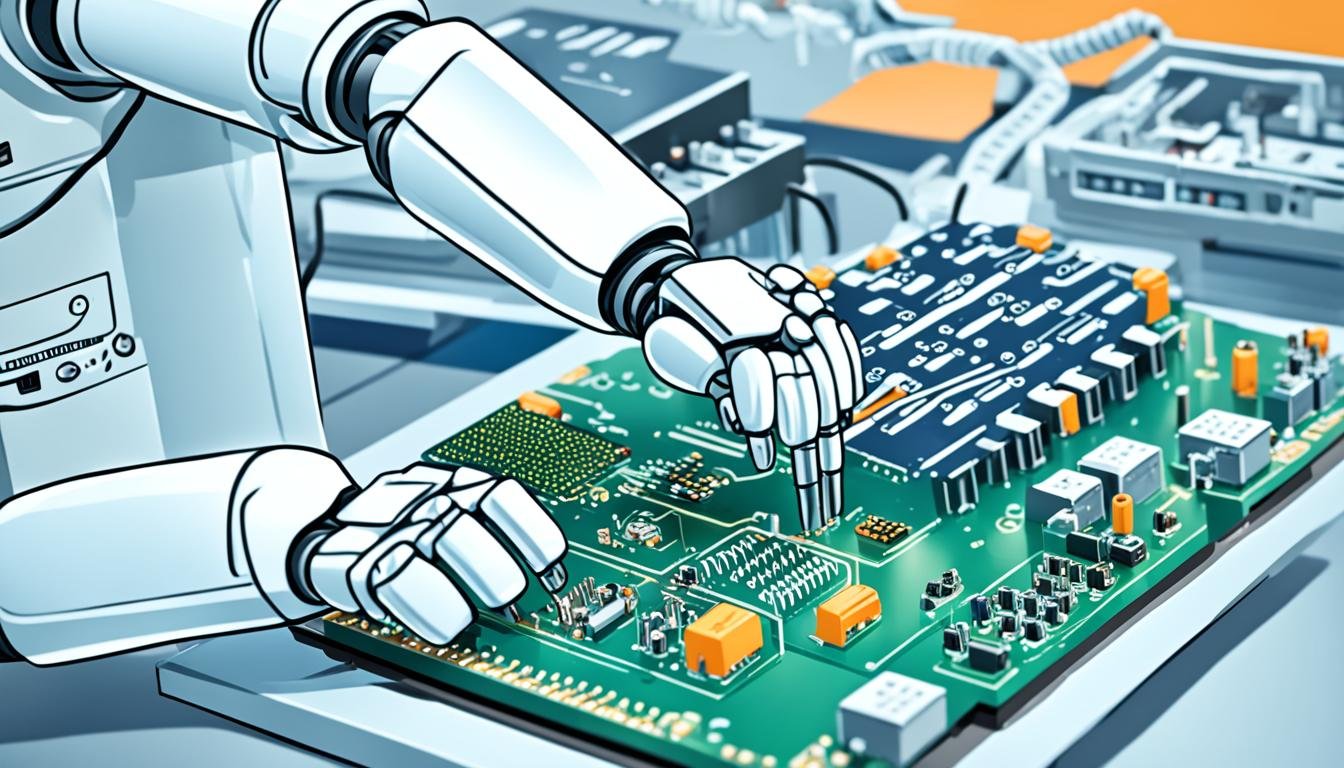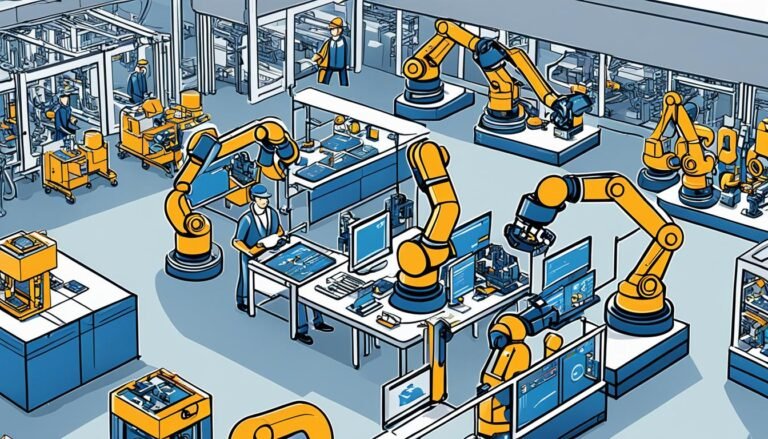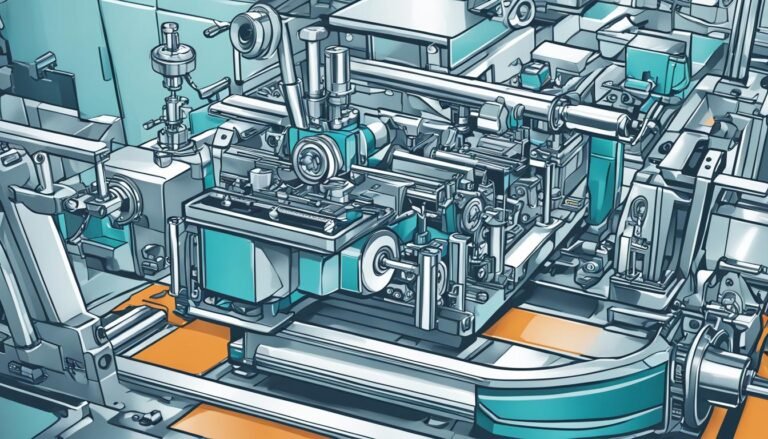Electronics Manufacturing: Powering Innovation
Did you know the global electronics manufacturing market will hit $460 billion by 2025? This shows how key electronics manufacturing is in pushing tech forward. It’s all about making the devices we use every day.
Manufacturers are now focusing on making things better together. This means they match what people want with what they make. It also helps cut down on waste. By working closely together, they make top-notch electronic parts for all kinds of devices.
Key Takeaways
- The electronics manufacturing market is set to reach $460 billion by 2025.
- Manufacturing electronics is central to technological innovation.
- Advanced PCB design and electronics assembly are pivotal in creating modern devices.
- Integrated manufacturing approaches reduce waste and align operations with market needs.
- High-quality electronic components are essential for both consumer and industrial applications.
The Role of Manufacturing Electronics in Modern Industry
Today, making electronics is key to innovation and changing our daily lives. It affects everything from small gadgets to big systems. New technology is making a big difference.
Importance of Circuit Boards
Circuit boards are crucial for modern electronics. These printed circuit boards (PCBs) help connect many parts together. This makes devices work faster and better. They turn electrical signals into something we can use.
Semiconductor Fabrication Advances
Semiconductor fabrication has seen big improvements lately. New methods like lithography and etching make semiconductors smaller and more powerful. This means our devices can do more with less energy and open up new ideas.
Applications in Consumer Electronics
These changes are clear in consumer electronics. New tech like surface mount technology makes making devices faster and more efficient. This leads to smaller, more reliable products. Things like the latest smartphones and smart home devices get better and more connected, making our lives easier.
The Impact of Industry 4.0 on Electronics Manufacturing
Industry 4.0 is changing how we make electronics. It uses automation, IoT, AI, and data analytics to make things better. This helps make products better, improves quality, and helps companies make smart choices to stay ahead.
IoT Integration for Process Optimization
Adding IoT to electronics making lets us watch and control production in real time. This connection helps machines and software talk to each other smoothly. This means making things more efficiently and less downtime, thanks to IoT giving important data for better processes.
AI for Enhanced Decision Making
AI is key in making better choices in making things. It uses learning machines and predictive analytics to look at lots of data. This helps predict when machines might break, plan production better, and make things more efficient. AI helps make quick decisions and manage resources well, saving money.
Data Analytics for Quality Control
Data analytics is crucial for keeping quality high in making electronics. By looking at data from different parts of production, companies can spot problems early. Using strong data analytics means fixing issues fast, keeping products top-notch, and cutting down on mistakes.
| Technology | Benefits | Application |
|---|---|---|
| Industrial Automation | Increased efficiency, reduced human error | Minimizing manual interventions |
| IoT | Real-time monitoring, process optimization | Live data tracking of machinery |
| AI | Predictive analysis, improved decision-making | Identifying machine faults beforehand |
| Data Analytics | Quality control, defect reduction | Analyzing production data |
Improving Efficiency Through Advanced Inventory and Supply Chain Management
In the fast-changing world of electronics manufacturing, managing inventory and supply chains well is key. It helps companies work better and stay ahead. Using lean manufacturing cuts waste and adds value for customers. A good strategy is using centralized inventory systems across different places. This makes sure resources are used well everywhere. Real-time control and visibility are also crucial for quick and flexible supply chain operations.
Centralized Multi-Site Inventory Management
Managing inventory in one place for many sites means working together on stock levels, buying, and shipping. It makes sure resources are there when needed, cutting down on delays and costs. Big companies like Intel and Apple have done this and seen big improvements in how fast they make products and save money. Here are some main benefits:
- Optimal resource allocation
- Reduction in holding costs
- Streamlined procurement processes
Real-Time Visibility and Control
Having real-time visibility lets manufacturers quickly see and act on changes. Advanced software helps companies work better together in their supply chains. For example, RFID and IoT tech track inventory and assets in real-time, giving detailed info on what’s happening. The good parts of real-time visibility and control include:
- Improved decision-making
- Enhanced responsiveness to supply chain disruptions
- Greater transparency across the supply chain
Adding lean manufacturing methods makes things even better. It focuses on making value and working efficiently, which boosts efficiency in making electronics.
| Aspect | Centralized Multi-Site Inventory Management | Real-Time Visibility and Control |
|---|---|---|
| Benefits | Resource Optimization, Reduced Costs | Enhanced Decision-Making, Immediate Response |
| Technologies Used | ERP Systems | RFID, IoT |
| Real-World Examples | Intel, Apple | Amazon, Cisco |
Innovations in Electronic Components and Materials
Innovation in electronic components and materials is key to making electronics better. These new technologies improve how well they work and how reliable they are. This brings big benefits to both those making electronics and those using them.
High-Purity Lithium Sulfide for Batteries
Lithium sulfide is changing the game in energy storage. It makes batteries hold more energy and last longer. This is a big step forward for electronic parts.
Fire Protection for Circuit Boards
Keeping circuit boards safe from fire is very important. New materials that resist fire have cut down the risk of overheating and fires. This makes electronic parts safer and more durable.
Thermal-Resistant Glass Manufacturing
New thermal-resistant glass is opening up new possibilities in electronics. This glass can handle very high temperatures. It also stays strong and clear, which is important for many high-performance uses.
The Role of Silicon Wafer Manufacturing in Technological Advancement
Silicon wafer manufacturing is key to our tech progress. It helps in fields like telecommunications, healthcare, renewable energy, and the automotive industry. This process makes sure modern innovations work well.
Telecommunications and 5G Networks
5G networks are changing how we connect and send data. Silicon wafers are vital for making semiconductors for 5G. These semiconductors make internet speeds faster and connectivity better, changing global communication.
Healthcare Innovations
In healthcare, silicon wafers are crucial for new medical devices. They help with imaging and surgery tools, making sure they work well and accurately. This tech helps improve patient care and brings new treatments.
Renewable Energy Solutions
Renewable energy, like solar power, needs efficient silicon wafers. Solar cells, which turn sunlight into electricity, use silicon wafers. So, silicon wafer manufacturing helps make renewable energy cheaper and more effective, pushing us towards sustainable power.
Automotive Industry Transformations
The car industry is changing, with more electric and smart cars on the road. Silicon wafers are key for making the electronics in these cars. They help with everything from battery management to self-driving tech, making cars smarter and safer.
| Industry | Application | Impact |
|---|---|---|
| Telecommunications | 5G Networks | Enhanced Connectivity |
| Healthcare | Diagnostic Equipment | Improved Patient Outcomes |
| Renewable Energy | Solar Cells | Sustainable Power |
| Automotive | Electric Vehicles | Technological Advancements |
Conclusion
Manufacturing electronics is key to the industry’s growth and global innovation. It touches sectors like consumer electronics, healthcare, telecommunications, and renewable energy. Advanced circuit boards, semiconductor fabrication, and silicon wafer making are crucial here.
These innovations improve processes and make products better. They also drive ongoing tech advancements.
Industry 4.0, with its focus on IoT, AI, and data analytics, has changed how we make things. It makes production more efficient and controls quality better. New components and materials like high-purity lithium sulfide for batteries help too.
Fire protection for circuit boards and thermal-resistant glass are also important. These innovations keep the electronics manufacturing sector leading in creating new solutions.
The mix of tech and material science makes electronics manufacturing a leader in global innovation. It keeps up with and goes beyond the needs of today’s tech world. This ensures its important role in future tech progress.







